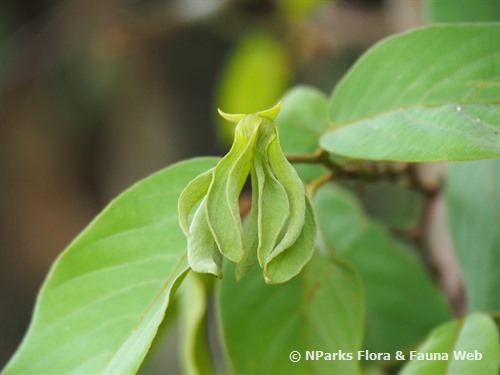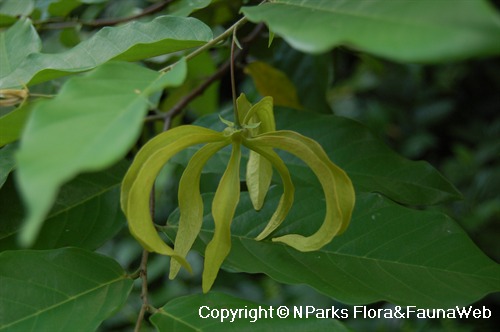
Name
Classifications and Characteristics
| Plant Division | Angiosperms (Flowering Seed Plants) |
|---|---|
| Plant Growth Form | Climber |
Biogeography
| Native Distribution | Myanmar, Thailand, Sumatra, Peninsular Malaysia, Singapore, and Java |
|---|---|
| Native Habitat | Terrestrial |
| Preferred Climate Zone | Tropical |
| Local Conservation Status | Native to Singapore (Critically Endangered (CR)) |
Description and Ethnobotany
| Growth Form | It is a woody climber up to 4 m long. |
|---|---|
| Foliage | Its alternate, stalked leaves have membranous to thinly papery leaf blades that are drop-shaped-elliptic to oblong, covered densely with hair below, and 5–16 by 2–7 cm. Its midrib is sunken and covered sparsely with fine hair above, and prominent below. |
| Flowers | Its flowers are greenish-yellow, have outer petals that are egg-shaped to drop-shaped and 4–6.5 by 1.5–3.5 cm, inner petals that are egg-shaped to lance-shaped, and 3–4 by 0.5–0.8 cm. |
| Fruit | Its dark purple fruits have 2–4 smooth seeds with brown seed coats. |
| Habitat | It grows in open areas, up to 1700 m altitude. |
| Associated Flora | It is pollinated by insects. |
| Etymology | Greek Desmos, bond or chain, probably referring to the appearance of the fruits; Latin dumosus, bushy, referring to the plant’s habit |
Landscaping Features
| Desirable Plant Features | Ornamental Flowers |
|---|---|
| Landscape Uses | Parks & Gardens, Trellis / Arbour / Pergola |
Fauna, Pollination and Dispersal
| Pollination Method(s) | Biotic (Fauna) |
|---|
Plant Care and Propagation
| Light Preference | Full Sun, Semi-Shade |
|---|---|
| Water Preference | Moderate Water |
References
| References | Sinclair, J.. 1955. A revision of the Malayan Annonaceae. Gardens’ Bulletin, Singapore . 14. 149-516 |
|---|
Image Repository
Others
| Master ID | 33791 |
|---|---|
| Species ID | 8207 |
| Flora Disclaimer | The information in this website has been compiled from reliable sources, such as reference works on medicinal plants. It is not a substitute for medical advice or treatment and NParks does not purport to provide any medical advice. Readers should always consult his/her physician before using or consuming a plant for medicinal purposes. |


